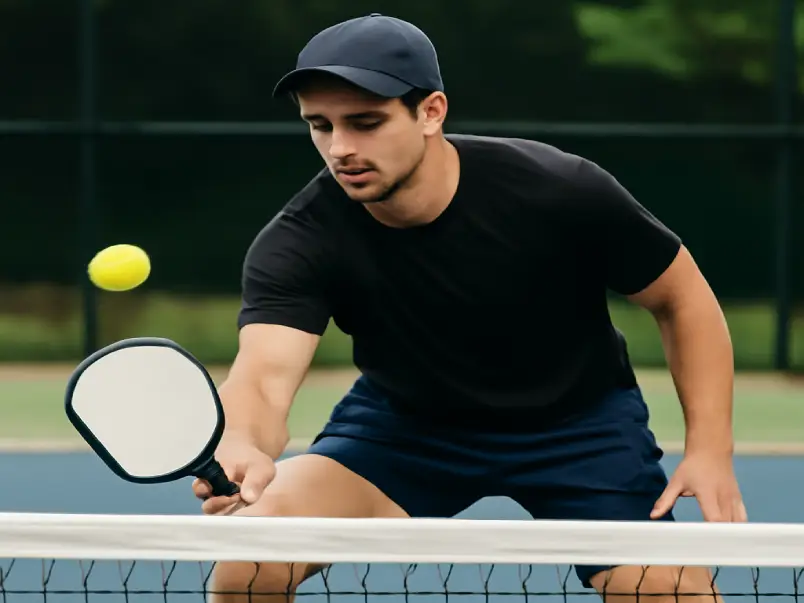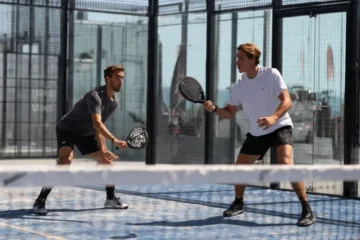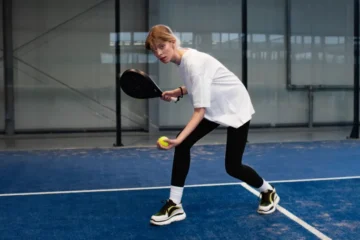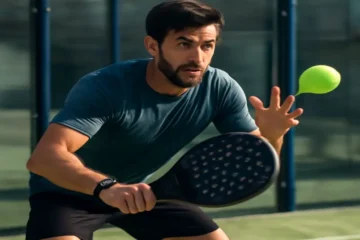In the world of pickleball, it’s easy to get caught up in the power of a smash or the speed of a drive. But there’s a shot that can completely change the game without relying on sheer force: the Dejada. This soft, deceptive shot has the power to baffle opponents, disrupt their rhythm, and win points by outsmarting them rather than overpowering them. In this guide, we’ll break down everything you need to know about the Dejada shot: what it is, why it’s so effective, how to execute it, and when to use it for maximum impact.
I. The Art of Deception
Have you ever hit a shot that seemed perfect, only to have your opponent return it with ease, effortlessly anticipating your every move? That feeling is a familiar one for many pickleball players. But what if there was a way to completely throw off your opponent, making them second-guess your every move? Enter the Dejada.
The Dejada is all about deception. It’s not about power or speed; it’s about timing and tricking your opponent into thinking you’re about to hit a fast, hard shot. At the last second, you gently push the ball, leaving your opponent scrambling and your game significantly stronger. In this article, we’ll show you how to master this effective and elusive shot that can transform your game.
II. What Exactly is a Dejada Shot?
Literal Meaning: From Spanish to the Court
The term Dejada comes from the Spanish verb dejar, meaning “to leave” or “to let go.” It refers to a soft, placed shot that seems to be heading in the direction of a powerful drive but then unexpectedly drops short. This sudden change catches your opponent off-guard, making it a highly effective weapon in your pickleball arsenal.
The Deception in Action
The beauty of the Dejada lies in its ability to mimic a more powerful shot. Here’s how it works:
- The Setup: The preparation for a Dejada looks almost identical to that of a strong drive or smash. Your back swing is full and deliberate, as though you’re gearing up to hit a fast shot.
- The Moment of Truth: Just as you’re about to make contact, you subtly adjust your grip. Instead of powering through the ball, you soften your hands, making the shot feel more like a push or slice. The result is a gentle drop that lands in the kitchen or non-volley zone, forcing your opponent to rush to the net.
- The Result: The ball lands just beyond their reach, often bouncing twice before they can react. The opponent, who was expecting a fast drive, is caught off guard, leading to a forced error or weak return.
III. Why the Dejada is a Game-Changing Weapon
Now that you understand the mechanics of the Dejada, let’s explore why it’s such a game-changer in pickleball.
Exploits Court Geometry
The Dejada forces your opponent to sprint from the baseline to the net. This sudden movement disrupts their position and balance, making it difficult for them to react effectively. The unexpected nature of the shot means they are often caught out of position, leaving you with a significant advantage.
Creates Unforced Errors
The Dejada often leads to mistakes from your opponent. Because they are expecting a deep drive, they may rush to the net, misjudge the bounce, or fail to reach the ball in time. These unforced errors are a key way to win points without needing to hit a powerful shot.
The Mental Game
One of the most powerful aspects of the Dejada is how it plays with your opponent’s mind. They are forced to constantly second-guess your next move, unsure of whether you’ll hit a powerful shot or pull off another deceptive Dejada. This mental pressure can break their rhythm, leading to mistakes and missed opportunities.
Sets Up the Next Shot
After a well-executed Dejada, your opponent is often left scrambling for a weak return. This creates the perfect opportunity for you to follow up with a powerful shot and finish the point. The Dejada is a strategic setup that gives you the upper hand in subsequent rallies.
IV. The Anatomy of a Perfect Dejada: A Step-by-Step Guide
Executing the Dejada is all about timing, finesse, and disguise. Let’s break down the key steps to perfecting this shot:
Step 1: The Disguise (The Most Important Part)
The key to a successful Dejada is making it look like a powerful shot until the very last moment. Here’s how to create the perfect disguise:
- Use the same ready position and full backswing as you would for a power shot.
- Keep your body language neutral. No signs of hesitation or change in posture—just a smooth and fluid motion.
- It’s important to maintain the illusion that you’re about to hit a fast ball, so avoid any early signals that you’re going for a soft shot.
Step 2: The Grip and Paddle Face
- Start with a firm grip for the backswing, just as you would for a power shot.
- At the point of contact, relax your grip slightly. This is crucial. The “soft hands” technique is key to creating the gentle push that defines the Dejada.
- Keep the paddle face slightly open to add a bit of backspin, helping the ball die in the kitchen or non-volley zone.
Step 3: The “Butterfly” Contact
This step refers to the unique feeling of Dejada contact:
- Instead of hitting through the ball, you want to “catch” it gently on the paddle face, creating a cushioning effect.
- The contact point is usually just in front of your body, and the follow-through is short and controlled. The goal is to create the illusion of a powerful shot while producing a soft drop.
Step 4: The Placement
Where you place the Dejada is just as important as how you execute it. Aim for the kitchen or non-volley zone:
- Cross-court placement is ideal, as it maximizes the distance your opponent must cover.
- The ball should ideally bounce twice before your opponent can reach it, making it difficult for them to return the shot.
V. When to Use the Dejada: Timing is Everything
Mastering the Dejada isn’t just about the execution—it’s about knowing when to use it for maximum effect. Here are some key situations where the Dejada can be a game-changing shot:
The Ideal Set-Up: Neutral or Offensive Rally
The Dejada works best when you’re in a neutral or offensive rally. From this position, you can catch your opponent off-guard by suddenly dropping the ball short.
Against Deep-Driving Opponents
If your opponent is consistently driving deep to the baseline, the Dejada is the perfect counter. When they’re camping out at the baseline, anticipating a deep shot, you can use the Dejada to pull them to the net and disrupt their position.
When Your Opponent is Moving Back
If your opponent is retreating to cover a deep shot, the Dejada can exploit this by sending them the wrong way. As they’re moving backward, the soft drop shot will be a challenging one to return.
To Break a Rhythm
If your opponent is in a fast-paced, power-based rally, using the Dejada is a great way to break their rhythm. The sudden change in pace and trajectory forces them to reset mentally and physically, giving you the advantage.
VI. Common Mistakes and How to Avoid Them
Even experienced players can make mistakes when trying to execute the Dejada. Here are some common pitfalls to watch out for:
The “Telegraphed” Dejada
Slowing your swing too early or showing any signs of hesitation can give away the surprise. Keep your motion fluid and disguise the shot until the very last moment.
Hitting it Too High
If you hit the Dejada too high, it can pop up and become an easy target for your opponent. Focus on hitting it low and soft, making it drop quickly into the kitchen.
Overusing the Shot
The Dejada is most effective when used as a surprise. If you overuse it, your opponent will start to anticipate it and adjust accordingly. Use it strategically and sparingly.
Poor Footwork
Executing a perfect Dejada requires good footwork. If you’re not in the right position, the shot will lack control and effectiveness. Ensure you’re balanced and well-positioned before making the shot.
VII. Drills to Practice Your Dejada
To master the Dejada, practice is essential. Here are three drills to help you perfect this shot:
Drill 1: The Shadow Swing
This drill helps you get the motion right without worrying about the ball. Practice the full backswing and then a soft, controlled follow-through without a ball. This helps build muscle memory for the deceptive motion.
Drill 2: Partner Disguise Drill
Have a partner feed you balls. As you prepare to swing, call out “POWER” or “DEJADA” at the last second. This will help you train your reaction time and improve your ability to disguise the shot effectively.
Drill 3: Target Practice
Place targets like cones or towels in the kitchen and aim for them with your Dejada. This will help you develop control and precision, ensuring you land the ball where you want it.
VIII. Conclusion: Elevate Your Game with Intelligence
The Dejada isn’t just a shot; it’s a tactical weapon that can elevate your entire game. By focusing on disguise, soft hands, and strategic placement, you’ll be able to outthink your opponents and force them into uncomfortable positions. Mastering this shot will turn you from a hitter into a complete, intelligent player who can dictate the flow of the game.
So next time you’re on the court, try adding the Dejada to your arsenal. It might just be the shot that wins you the game, not through brute force, but through finesse, timing, and intelligence. Happy playing!
FAQs
What is the Dejada shot in pickleball ?
The Dejada is a soft, deceptive shot that appears to be a powerful drive but drops short in the kitchen or non-volley zone. It catches your opponent off-guard by mimicking a fast shot and then softening at the last moment.
When should I use the Dejada shot ?
The Dejada is ideal when you’re in a neutral or offensive rally, against opponents who camp at the baseline, or when you want to break your opponent’s rhythm. It’s also great when your opponent is moving back to cover a deep shot.
What are the key components of executing a perfect Dejada ?
The key components include disguising the shot with a full backswing, using a soft grip (relaxed “soft hands”) at the moment of contact, and aiming for the kitchen or non-volley zone, typically cross-court to make the ball land short.
What mistakes should I avoid when executing the Dejada shot ?
Common mistakes include telegraphing the shot too early, hitting the ball too high, overusing the shot, and poor footwork. Ensure that your swing remains fluid and you’re well-positioned before attempting the Dejada.
How can I practice the Dejada shot ?
You can practice through drills like the shadow swing, partner disguise drill, and target practice. These drills help you develop muscle memory, improve reaction time, and refine your aim and control.
Why is the Dejada shot considered a strategic weapon ?
The Dejada creates unforced errors from your opponent, disrupts their balance, and frustrates them by forcing them to second-guess your next move. It allows you to win points without relying on raw power.




